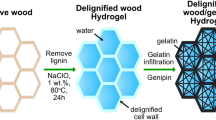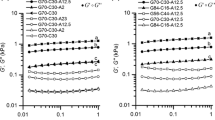Abstract
Mixing boron with two thermoreversible hydrogels, obtained from an amphiphilic tripeptide and a carbamate derivative of glycerol, respectively, allows the formation of a supramolecular network that incorporates boron and significant amounts of water upon gelification of the solution when the temperature decreases. Hydrogels obtained from these gelators were impregnated in pine sapwood blocks using vacuum pressure treatment and subjected to leaching. Results indicated that incorporation of boron salts in the hydrogel network effectively protected the wood from degradation caused by the brown rot fungus Poria placenta and from attack by termites also even after leaching. It is believed that these hydrogels fill the tracheid cell walls and lumens, limiting the leachability of boron salts when the wood is humidified.


Similar content being viewed by others
References
AWPA (2008) A7-04 Standard for wet ashing procedures for preparing wood for chemical analysis. American Wood Protection Association Standard, Birmingham
Baysal E, Ozaki SK, Yalinkilic MK (2004) Dimensional stabilization of wood treated with furfuryl alcohol catalysed by borates. Wood Sci Technol 38(6):405–415
Drysdale AJ (1994) Boron treatments for the preservation of wood—a review of efficacy data for fungi and termites. Document No. IRG/WP 94-30037. International Research Group on Wood Preservation, Stockholm
Ellis ET (1965) Inorganic elements in wood. In: Côte WA Jr (ed) Cellular ultrastructure of woody plants. Syracuse University Press, New York, pp 181–189
European Committee for Standardization (1986) Wood preservatives—determination of toxic values of wood preservatives against wood destroying basidiomycetes cultured on agar medium. NF EN 113. AFNOR
European Committee for Standardization (1990) Wood preservatives—determination of toxic values against Reticulitermes santonensis de Feytaud (laboratory method). NF EN 117. AFNOR
European Committee for Standardization (1994) Wood preservatives—methods for measuring losses of active ingredients and other preservative ingredients from treated timber—part 2: laboratory method for obtaining samples for analysis to measure losses by leaching into water or synthetic sea water. ENV 1250-2, Brussels, Belgium
European Committee for Standardization (2007) Durability of wood and wood-based products—definition of use classes—part 2: application to solid wood. EN 335-2. AFNOR
Gezer ED, Michael JH, Morrell JJ (1999) Effects of glycol on leachability and efficacy of boron wood preservatives. Wood Fiber Sci 31(2):136–142
Gizzi P, Pasc A, Dupuy N, Parant S, Henry B, Gérardin C (2009) Molecular tailored histidine-based complexing surfactants: from micelles to hydrogels. Eur J Org Chem 23:3953–3963
Kartal SN, Green F (2003) Leachability of boron from wood treated with natural and semi-synthetic polymers and calcium precipitating agent. Holz Roh Werkst 61(5):388–389
Kartal SN, Imamura Y (2004) Effects of N′-N-(1,8-naphthalyl)hydroxylamine (NHA-Na) and hydroxynaphthalimide (NHA-H) on boron leachability and biological degradation of wood. Holz Roh Werkst 62(5):378–385
Kartal SN, Yoshimura T, Imamura Y (2004) Decay and termite resistance of boron-treated and chemically modified wood by in situ co-polymerisation of allyl glycidyl ether (AGE) with methyl methacrylate (MMA). Int Biodeter Biodegr 53:111–117
Kartal SN, Yoshimura T, Imamura Y (2009) Modification of wood with Si compounds to limit boron leaching from treated wood and to increase termite decay resistance. Int Biodegr Biodeter 63(2):187–190
Lloyd JD (1997) International status of borate preservatives systems. Proceeding of Second international conference on wood protection with diffusible preservation and pesticides, Forest Products Society, Mobile, Alabama, USA, pp 45–54
Lloyd JD (1998) Borates and their biological applications. Document No. IRG/WP 98-30178. International Research Group on Wood Preservation, Stockholm
Lloyd JD, Dickinson DJ, Murphy RJ (1990) The probable mechanisms of action of boric acid and borates as wood preservatives. Document No. IRG/WP 1450. International Research Group on Wood Preservation, Stockholm
Loos M, Feringa BL, Van Esch JH (2005) Design and application of self-assembled low molecular weight hydrogels. Eur J Org Chem 17:3615–3631
Mitra RN, Das D, Roy S, Das PK (2007) Structure and properties of low molecular weight amphiphilic peptide hydrogelators. J Phys Chem B 111(51):14107–14113
Mohareb A, Van Acker J, Stevens M (2002) Effect of protective additives on leachability and efficacy of borate treated wood. Document No. IRG/WP 02-30290. International Research Group on Wood Preservation, Stockholm
Mohareb A, Thévenon M-F, Wozniak E, Gérardin P (2010) Effects of monoglycerides on leachability and efficacy of boron wood preservatives against decay and termites. Int Biodeter Biodegr 64(2):135–138
Mohareb A, Thévenon M-F, Wozniak E, Gérardin P (2011) Effects of polyvinyl alcohol on leachability and efficacy of boron wood preservatives against fungal decay and termites attack. Wood Sci Technol 45(2):369–382
Mourant D, Yang DQ, Lu X, Riedl B, Roy C (2009) Copper and boron fixation in wood by pyrolytic resins. Bioresour Technol 100(3):1442–1449
Naskar J, Palui G, Banerjee A (2009) Tetrapeptide based hydrogels: for encapsulation and slow release for an anticancer drug at physiological pH. J Phys Chem B 113(35):11787–11792
Obanda DN, Shupe FT, Barnes HM (2008) Reducing leaching of boron based wood preservatives—a review of research. Bioresour Technol 99(15):7312–7322
Obounou-Akong F, Gérardin P, Gérardin-Charbonnier C (2012) Smart hydrogels from low molecular weight amphiphilic compounds: toward a solution to decrease leachability and increase efficacy of boron preservatives? Document No. IRG/WP 12-30589. International Research Group on Wood Protection, Kuala Lumpur
Obounou-Akong F, Pasc A, Mutlu M, Cosgun S, Gerardin-Charbonnier C (2013a) Hydrogels obtained from an original catanionic system for efficient formulation of boron wood-preservatives. J Int Biodegr Biodeter 77:123–126
Obounou-Akong F, Pasc A, Emo M, Gérardin-Charbonnier C (2013b) A supramolecular hydrogel based on an original pseudopeptidic catanionic surfactant. New J Chem 37:559–562
Pal A, Dey J (2011) Water-induced physical gelation of organic solvents by N-(n Alkylcarbamoyl)-l-alanine amphiphiles. Langmuir 27(7):3401–3408
Pasc A, Gizzi P, Dupuy N, Parant S, Henry B, Gérardin C (2009) Microscopic and macroscopic anisotropy in supramolecular hydrogels of histidine-based surfactants. Tetrahedron Lett 50(45):6183–6186
Pasc A, Obounou-Akong F, Cosgun S, Gérardin C (2010) Differences between β-Ala and Gly-Gly in the design of amino acids-based hydrogels. Beilstein J Org Chem 6:973–977
Patra T, Pal A, Dey J (2010) A smart supramolecular hydrogel of N-(4-n-Alkyloxybenzoyl)-l-histidine exhibiting pH-modulated properties. Langmuir 26(11):7761–7767
Pezron E, Richard A, Lafuma F, Audebert R (1988) Reversible gel formation induced by ion complexation. 1. Borax-galactomannan interactions. Macromolecules 21(4):1121–1125
Sagawa T, Chowdhury S, Takafuji M, Ihara H (2006) Self-assembled nanofibrillar aggregates with amphiphilic and lipophilic molecules. Macromol Symp 237(1):28–38
Sangeetha NM, Maitra U (2005) Supramolecular gels: functions and uses. Chem Soc Rev 34(10):821–836
Schoeman WM, Lloyd JD (1998) International standardisation: a hypothetical case study with stand-alone borate wood preservatives. Document No. IRG/WP 98-20147. International Research Group on Wood Preservation, Stockholm
Steed J (2011) Supramolecular gel chemistry: developments over the last decade. Chem Commun 47(5):1379–1383
Temiz A, Alfredsen G, Eikenes M, Terziev N (2008) Decay resistance of wood treated with boric acid and tall oil derivates. Bioresour Technol 99(7):2102–2106
Terech P, Weiss RG (1997) Low molecular mass gelators of organic liquids and the properties of their gels. Chem Rev 97(8):3133–3160
Thévenon M-F, Pizzi A (2003) Polyborate ions’ influence on the durability of wood treated with non-toxic protein borate preservatives. Holz Roh Werkst 61(6):457–464
Thevenon M-F, Pizzi A, Haluk JP (1998) Protein borates as non-toxic, long-term, wide-spectrum, ground-contact wood preservatives. Holzforschung 52(3):241–248
Thévenon M-F, Pizzi A, Haluk JP (1997) Non-toxic albumin and soya protein borates as ground-contact wood preservatives. Holz Roh Werkst 55(5):293–296
Toussaint-Dauvergne E, Soulounganga P, Gérardin P, Loubinoux B (2000) Glycerol/glyoxal: a new boron fixation system for wood preservation and dimensional stabilization. Holzforschung 54(2):123–126
Yang Z, Xu B (2007) Supramolecular hydrogels based on biofunctional nanofibers of self-assembled small molecules. J Mater Chem 17(23):2385–2393
Acknowledgments
The authors gratefully acknowledge the financial support of the CPER 2007–2013 “Structuration du Pôle de Compétitivité Fibres Grand’Est” (Competitiveness Fibre Cluster), Salveco and the “Région Lorraine”. The EA 4370 LERMAB is supported by the French National Research Agency through the Laboratory of Excellence ARBRE (ANR-12- LABXARBRE-01).
Author information
Authors and Affiliations
Corresponding author
Rights and permissions
About this article
Cite this article
Obounou-Akong, F., Gérardin, P., Thévenon, MF. et al. Hydrogel-based boron salt formulations for wood preservation. Wood Sci Technol 49, 443–456 (2015). https://doi.org/10.1007/s00226-015-0701-4
Received:
Published:
Issue Date:
DOI: https://doi.org/10.1007/s00226-015-0701-4




